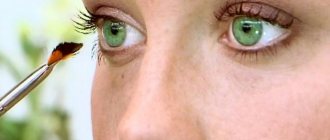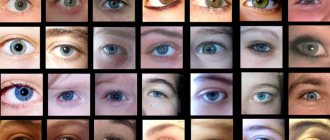All people with blue eyes are descended from the same ancestor.
Share on FacebookVKontakteTwitterOdnoklassniki
Blue eyes arose relatively recently - from 6 to 10 thousand years ago. It was possible to identify a gene that mutated in one person during a specified period of time, and ultimately became the progenitor of all blue-eyed people on the planet.
Professor Hans Eyberg from the Department of Cellular and Molecular Medicine at the University of Copenhagen began the research in 1996. To begin with, he identified the OCA2 gene, which is responsible for eye color. Over the next decade, he and his colleagues studied mitochondrial DNA and compared the eye color of people in Denmark, Jordan, and Turkey, including both light-skinned and dark-skinned people with blue eyes. It turned out that 99.5% of people who took a DNA test had the same mutation.
“Originally we all had brown eyes. But a genetic mutation affecting the OCA2 gene on our chromosomes created a switch that literally turned off the ability to produce brown eyes,” Eiberg comments on the discovery.
Since eye color is determined by genetics, the frequency of distribution of certain colors is one of the characteristic features of each nation. Russia, according to the results of studies in 1909, among Russians at the beginning of the 20th century the distribution was approximately as follows: gray 50%; brown 25%; blue and cyan 20%; black and green 5% In 1955 - 1959, an anthropological expedition was carried out during which 17 thousand people of the Russian population of the RSFSR were studied. Eye color was determined using the Bunak scale. The following results were obtained: Men – light type (44.75%) – transitional type (49.66%) – dark type (5.59%) – sample (8754); Women – light type (42.07%) – transitional type (50.72%) – dark type (7.21%) – sample (8074); In total – light type (43.46%) – transitional type (50.17%) – dark type (6.37%) – sample (16828).
Blue eye. The outer layer of the vessels of the iris, formed from collagen fibers, is dark blue in color. If the fibers of the outer ectodermal layer of the iris are characterized by low density and low melanin content, then it has a blue color. There are no blue or cyan pigments in the iris and in the eye at all. The blue color is the result of light scattering in the stroma. The inner layer of the iris, unlike the outer one, is always saturated with melanin and has a black-brown color. As a result, part of the high-frequency component of the spectrum of light incident on the eye is scattered in the turbid environment of the stroma and reflected, and the low-frequency component is absorbed by the inner layer of the iris. The lower the density of the stroma, the richer the blue color.
Blue eye. Unlike blue eyes, in this case the density of collagen fibers in the stroma is higher. Since they have a whitish or grayish tint, the color will no longer be blue, but blue. The higher the fiber density, the lighter the color. Blue eye color is the result of a mutation in the HERC2 gene, due to which carriers of this gene have reduced melanin production in the iris of the eye.
Blue and dark blue eyes are most common among the European population, especially in the Baltics and Northern Europe. In Estonia, up to 99% have this eye color. In Denmark in the 1970s, only 8% had dark eyes, while now, as a result of migration, this figure has risen to 11%. According to a 2002 study, among the Caucasian population of the United States born in 1936-1951, carriers of blue and blue eyes make up 33.8%, while among those born in 1899-1905 this figure is 54.7%. According to 2006 data, this figure for modern white Americans has dropped to 22.3%. Blue and blue eyes are also found in the Middle East, for example, in Afghanistan, Lebanon, Iran.
Gray eye (steel shade). The definition of gray and blue eyes is similar, only the density of the fibers of the outer layer is even higher and their shade is closer to gray. If the density is not so high, then the color will be gray-blue. The presence of melanin or other substances produces a small yellow or brownish impurity. Gray eye color is most common in Eastern and Northern Europe. For Russians, this color, according to 1909 data, reached 50%. It is also found in Iran, Afghanistan, Pakistan and parts of Northwest Africa.
Green eye. Green eye color is determined by a small amount of melanin. The outer layer of the iris contains the yellow or light brown pigment lipofuscin.
Light brown eyes
The characters of brown and light brown people are significantly different. Here people are more calm and reasonable. They are shy and seek privacy.
These are responsible people. Any work is performed conscientiously and on time. You can always rely on them.
They achieve great success in their careers thanks to perseverance, diligence and hard work.
They need to receive affection and gratitude from others, when they themselves are quite secretive and shy.
Character of girls with black and brown eyes
They are able to change and rule the world, but achieving this through the hands of others. The main trump card of such girls is wisdom and attractiveness.
In love, they show themselves as a decisive, strong and passionate person. She's a creepy owner, but she hides it.
They don't like being pressured. They take a responsible approach to doing their work. They achieve great success in business. Independent and disciplined.
It is better to choose a partner with gray eyes as a life partner.
Character of men with brown and black eyes
The character of such men is significantly different from girls. They have a good reputation at work, are hardworking and responsible. They rarely become bosses.
They fall in love quickly and cool down just as quickly. They lead a dissolute life, they can easily change, although they will not tolerate betrayal towards themselves.
The main drawback is selfishness.
How to find out your nationality
In combination with the blue or cyan color resulting from scattering in the stroma, the result is green. The color of the iris is usually uneven and there are many different shades. The red hair gene may play a role in its formation. Pure green eye color is extremely rare. Its speakers are found in Northern and Central Europe. According to studies of the adult population of Iceland and Holland, green eyes are much more common in women than in men.
Source
Click " Like " and get the best posts on Facebook!
Share on FacebookVKontakteTwitterOdnoklassniki
Green-brown eyes
This color is very rare. They are considered to be powerful people. They contain magic, mystery and attractiveness that captivates everyone.
If necessary, show courage and bravery. They do not change their positions in life and respect the opinions of others.
In communication they are very kind, friendly and delicate. They have a logical mind and wisdom.
Character of a woman
The girl with green-brown eyes is very beautiful. Easily attracts men's gaze and wins hearts. They are always faithful to their partner.
These girls are charged with unstoppable energy, which they share with others.
Those with the same eye color, green-brown, are perfect for spouses.
Where did green eye color come from and its uniqueness?
Scientists studying the genetics of eye color have found that more than 99.5% of blue-eyed people who agreed to have their DNA analyzed have the same tiny mutation in the gene that determines iris color.
This, according to Professor Hans Eiberg and his colleagues from the University of Copenhagen, means that the mutation occurred in just one person, who became the ancestor of all blue-eyed people from subsequent generations.
Scientists cannot pinpoint exactly when this mutation took place, but other clues indicate that it most likely occurred about 10,000 years ago, when Europe was rapidly populated by the spread of agriculture from the Middle East.
“The mutations causing blue eyes most likely occurred in the northwestern Black Sea region, where large agricultural migrations to northern Europe took place during the Neolithic period, approximately 6,000 to 10,000 years ago,” the scientists write in the journal Human Genetics. .
Professor Eyberg said brown was the "default" color of human eyes, caused by the dark pigment in the skin, melanin. However, in Northern Europe, a mutation occurred in the OCA2 gene, which disrupted the production of melanin in the iris and led to the appearance of blue eyes.
“At first everyone had brown eyes,” said Professor Eyberg. “But a mutation in the OCA2 gene on our chromosomes caused a switch that literally turned off the ability to produce brown eyes.”
Variations in eye color can be explained by the amount of melanin in the iris, but among blue-eyed people there is little variation in the amount of melanin in the eyes, the professor said.
“From this, we can conclude that all blue-eyed people have one common ancestor. They all inherited the same change in the same place in their DNA,” Eiberg said.
Men and women with blue eyes have an almost identical genetic sequence for the part of their DNA that determines their eye color. In brown-eyed people, on the other hand, there is a significant amount of individual variation in this part of the DNA.
Professor Eyberg said he analyzed the DNA of almost 800 blue-eyed people, from fair-skinned blond Scandinavians to dark-skinned people with blue eyes living in Turkey and Jordan.
“All of them, except perhaps one, had the same DNA sequence in the OCA2 gene region. This to me is very clear evidence that all these people must have one single common ancestor,” he said.
It is not known why blue eyes are most common among residents of Northern Europe and southern Russia. Previously encountered explanations include suggestions that blue eye color either conferred some advantage on white nights in summer or polar nights in winter, or was considered attractive and therefore more favorable for sexual selection.
All people with blue eyes are descended from the same ancestor.
Share on FacebookVKontakteTwitterOdnoklassniki
Blue eyes arose relatively recently - from 6 to 10 thousand years ago. It was possible to identify a gene that mutated in one person during a specified period of time, and ultimately became the progenitor of all blue-eyed people on the planet.
Professor Hans Eyberg from the Department of Cellular and Molecular Medicine at the University of Copenhagen began the research in 1996. To begin with, he identified the OCA2 gene, which is responsible for eye color. Over the next decade, he and his colleagues studied mitochondrial DNA and compared the eye color of people in Denmark, Jordan, and Turkey, including both light-skinned and dark-skinned people with blue eyes. It turned out that 99.5% of people who took a DNA test had the same mutation.
“Originally we all had brown eyes. But a genetic mutation affecting the OCA2 gene on our chromosomes created a switch that literally turned off the ability to produce brown eyes,” Eiberg comments on the discovery.
Since eye color is determined by genetics, the frequency of distribution of certain colors is one of the characteristic features of each nation. Russia, according to the results of studies in 1909, among Russians at the beginning of the 20th century the distribution was approximately as follows: gray 50%; brown 25%; blue and cyan 20%; black and green 5% In 1955 - 1959, an anthropological expedition was carried out during which 17 thousand people of the Russian population of the RSFSR were studied. Eye color was determined using the Bunak scale. The following results were obtained: Men – light type (44.75%) – transitional type (49.66%) – dark type (5.59%) – sample (8754); Women – light type (42.07%) – transitional type (50.72%) – dark type (7.21%) – sample (8074); In total – light type (43.46%) – transitional type (50.17%) – dark type (6.37%) – sample (16828).
Blue eye. The outer layer of the vessels of the iris, formed from collagen fibers, is dark blue in color. If the fibers of the outer ectodermal layer of the iris are characterized by low density and low melanin content, then it has a blue color. There are no blue or cyan pigments in the iris and in the eye at all. The blue color is the result of light scattering in the stroma. The inner layer of the iris, unlike the outer one, is always saturated with melanin and has a black-brown color. As a result, part of the high-frequency component of the spectrum of light incident on the eye is scattered in the turbid environment of the stroma and reflected, and the low-frequency component is absorbed by the inner layer of the iris. The lower the density of the stroma, the richer the blue color.
Blue eye. Unlike blue eyes, in this case the density of collagen fibers in the stroma is higher. Since they have a whitish or grayish tint, the color will no longer be blue, but blue. The higher the fiber density, the lighter the color. Blue eye color is the result of a mutation in the HERC2 gene, due to which carriers of this gene have reduced melanin production in the iris of the eye.
Blue and dark blue eyes are most common among the European population, especially in the Baltics and Northern Europe. In Estonia, up to 99% have this eye color. In Denmark in the 1970s, only 8% had dark eyes, while now, as a result of migration, this figure has risen to 11%. According to a 2002 study, among the Caucasian population of the United States born in 1936-1951, carriers of blue and blue eyes make up 33.8%, while among those born in 1899-1905 this figure is 54.7%. According to 2006 data, this figure for modern white Americans has dropped to 22.3%. Blue and blue eyes are also found in the Middle East, for example, in Afghanistan, Lebanon, Iran.
Gray eye (steel shade). The definition of gray and blue eyes is similar, only the density of the fibers of the outer layer is even higher and their shade is closer to gray. If the density is not so high, then the color will be gray-blue. The presence of melanin or other substances produces a small yellow or brownish impurity. Gray eye color is most common in Eastern and Northern Europe. For Russians, this color, according to 1909 data, reached 50%.
What causes green eye color?
The iris of the eyes consists of two layers - anterior and posterior. The last layer is dark in all cases, even in blue-eyed people, the only exception being albinos, for them it is almost colorless. Melanin accumulates in the top layer, which is responsible for the shade of the iris. The more of this coloring substance, the darker a person’s eyes. If there is little melanin in the upper layer, then the person has blue, gray or green eyes.
Green eye color is considered the rarest. This tone is due to the low level of melanin and the presence of a special dye called lipofuscin in the anterior layer. Green-eyed people are rarely seen. In this case, the shade can vary significantly. Some people have almost emerald irises, others have swamp-colored eyes, and still others have dark green eyes.
It should be noted that a person should not have a yellow iris. If such a phenomenon is observed, then we are talking about problems with the liver or bile ducts.
Eyes as a racial sign
One of the most important signs by which a person’s overall belonging to his racial and biological circle is determined is eye color. In legends and folk tales of all peoples of the earth since ancient times, one can trace the degree of importance of eye color in identification according to the principle of “friend or foe.” However, meaningful study of this most important anthropological parameter began only at the end of the 19th century. Gustav Fritsch (1839–1891) was one of the first to point out racial differences in the retina, and Eugen Fischer (1874–1967) discovered the correspondence of pigment cells in the mucous membrane of animals and the “lower” races of humanity.
Finally, Max Wolfgang Hauschild (1883–1924) in turn confirmed the existence of three different types of pigment cells in the iris of the black, yellow and white races, a fact that was reflected in the interpretation of cultural differences. The prominent Russian anthropologist P. A. Minakov in his article 'The Importance of Anthropology in Medicine' (Russian Anthropological Journal. No. 1, 1902) pointed out: 'Many peoples do not distinguish between some colors of the spectrum. For example, Arabs use the words black, green and brown as synonyms. Koreans do not distinguish between green and blue, calling these colors in one word 'Pehurada'. The Bongo tribe, living in Central Africa, also uses one word for black, blue and green - 'Kamakulutsch'. This tribe has a color scale of three colors: black, red and white.
It should be noted that with these characteristics, many savages are characterized by extraordinary visual and hearing acuity, allowing the savage to distinguish in detail very distant objects and hear clearly the faintest noise, completely inaccessible to the ear of a European; however, harmonic combinations of sounds, colors and tones are little accessible to the savage.'
A certain 'lowness' of origin from an evolutionary point of view is also evidenced by other morphological features in the structure of the eyes, the concentration of which is different in all races. It is the frequency of occurrence of these rudimentary traits in a particular population that indicates its evolutionary position. The prominent Swedish anthropologist Wilhelm Lehe in his book 'Man, His Origin and Evolutionary Development' (M., 1913) emphasized: 'In the inner corner of the eye there is a small light red membrane, the so-called semilunar fold (conjunctiva) - a formation that cannot be attributed neither any function nor any benefit. It is better developed among some wild peoples (Negroes, Malays) than among Europeans.' The famous German scientist Georg Buschan, in the book we have repeatedly cited above, in turn noted: “The third eyelid, or Plica Semilunaris, is a vertically standing fold of the connective tissue of the eye and is a remnant of the nictitating membrane of animals, especially pronounced in birds, amphibians and reptiles. As a memory of this condition, it is preserved in humans in the form of a small cartilaginous rudiment, which sometimes occurs especially often in lower races, for example, among blacks in 75%, and among the white race, only in 0.5%.
Also, the Soviet scientist B.S. Zhukov wrote: “The semilunar fold near the eye in representatives of lower races is somewhat more highly developed than, for example, in representatives of European peoples.”
What is the rarest eye color?
From which it follows that the structure of the eyes themselves and the organs surrounding them contains a whole bunch of morphological characteristics that make it possible with a high degree of probability to judge the evolutionary value of this or that individual from a racial point of view.
Structural differences in the location of the eyes are no less significant. The lower target of the orbit is very narrow in gorillas, in people it is wider, especially in Negroids, in Caucasians it is less wide, and the narrowest in Mongoloids. Baron Egon von Eickstedt wrote in this regard: “A very wide gap, like that of a Wute Negro, can be considered an infantile-primitive feature, but only within the framework of human series: in humans, the structure of the orbit developed in a special direction. This is also evidenced by the protrusion of the frontomaxillary suture on the inner wall of the orbits, caused by the protrusion of the maxillary bone. This is usually among gorillas and chimpanzees, but very rarely among people, only among animal-like primitive races. Negritos, Bushmen and Veddas have an absolute maximum capacity of the entrance plane of the eye sockets, which makes their skulls seem more sinister. The shape of the orbits is determined using the orbital pointer. Low and usually more rectangular forms, like those of the Tasmanians, New Zealanders, Fuegians and Guanches, have an index of about 80, while the more rounded and tall forms of the Chinese, Eskimos and Polynesians have about 90. The racial peculiarity of the orbits of the Mongoloids is also expressed in the location of the line of their maximum width stretching; among Europeans this line is much more inclined to the horizontal than among the Japanese, which indicates a higher location of the entire outer orbital region among the Mongoloids. In general, their eyeball has a more frontal location. Races differ in the distance between the eyes, and most importantly in the structure of the retina. Egon von Eickstedt pointed out: 'In monkeys the retina has a very fine structure, among people the Bushmen, the Veddas, and to a lesser extent the Negroids come close to them. The opinion that savages have better eyes is not supported by convincing arguments. The rough and poorly branched cells of the iris of Negroids are filled with pigment cells; Mongoloids have more of these cells, but they are smaller; Europeans have fewer of these cells, but they are more delicate. In dark-skinned races, this membrane covers the conjunctiva and pupil, as a result of which the latter appears not white, but yellowish, and its edge has a brown border.
Newborn Europeans usually have blue or dark purple, gray-blue eyes, Negroids have brown eyes, Mongoloids have greenish-brown eyes.
Of interest from the point of view of evolutionary history are the muscles for closing the eyelids. In primitive races they are still associated with the muscles of the nasal region. The higher ones are completely independent. So among Europeans they are clearly divided into three subgroups. The formation of cartilage on the conjunctiva is a distinctive feature of monkeys; it is quite common in Negroids, less often in Mongoloids, and is almost completely absent in Caucasians. This pattern was discovered by Paul Rudolf Bartels (1874–1914) and Buntaro Adahi. But the Mongoloid eyes have the most noticeable features. The orbits of Mongoloids are located much higher on the outside than those of Europeans, which gives the impression of squint and slight bulging eyes of representatives of the yellow race. But the main feature of Mongoloid eyes is the palpebral fissure, on which facial expression largely depends. In northern Europeans it usually has the shape of a spindle, in people of the Oriental race it is almond-shaped. Egon von Eickstedt pointed out many other rudimentary formations in the structure of the eyes of representatives of the black, yellow races and their mestizos: epicanthus, Hottentot fold, Negro fold, peach eyelid, tarsal eyelid, clubbed eyelid. All these morphological anomalies were inherited by representatives of these races from their animal ancestors, and their high degree of concentration indicates mutual evolutionary proximity. The color of the eyes of representatives of different races today is measured using the Rudolf Martin scale (1864–1925).
The further development of anthropology and ethology - the science that studies the biological foundations of human behavior - continued in the same direction, and many facts of social life, previously explained by the action of abstract cultural differences, now received a completely different interpretation. The position of biological determinism has strengthened significantly. A major modern American researcher, Morgan Worthy, published in 1974 a very remarkable book, Eye Color, Sex and Race (Keys to the Behavior of People and Animals), in which, based on a wealth of statistical material, he explained many fundamental differences in the behavior of people of different races.
It turned out that people with dark eyes react more to color, and people with light eyes react more to shape. Dark-eyed individuals are especially sensitive to colors in the long-wavelength part of the spectrum, since strong pigmentation partially blocks short-wavelength light. That is why southerners prefer red and yellow colors, and northerners prefer blue and gray. In addition, light-eyed blonds of the Nordic race are better able to distinguish between tones and navigate in space. Dark-eyed people, who react more to color, are prone to spontaneous and emotional reactions, while light-eyed people, who react more to form, prefer to control their emotions. Dark-eyed people love close communication, while light-eyed people, on the contrary, base all forms of behavior on distance, considering the reduction of interpersonal space to be bad form. Dark-eyed people prefer to follow social patterns in everything, while light-eyed people develop their life position based on the laws of internal style.
The conclusion in Morgan Worthy's work, although shockingly simple, is nevertheless well argued: "People with blue eyes perceive primarily form and have a scientific mind, while people with brown eyes perceive color and have an unscientific mind."
The racial analysis of inventors and innovators leaves no doubt that true science is the creation primarily of representatives of the Nordic race. Consequently, the worldview developed by a brown-eyed person will never become the true property of a blue-eyed person, because the specifics of the worldview and eye color are interconnected.
Date added: 2015-02-25; ;
Brown color
Owners of brown eyes are emotional, energetic and impressionable.
This is a holiday people. They are able to instantly lift the mood of themselves and those around them. It is important for them to be in the center of attention, to receive praise and compliments.
Often these are powerful and passionate people who want to achieve their goal at any cost. They are touchy, but quickly move away and do not hold a grudge.
People with brown eyes are very friendly, attractive, charming and confident. They make contact easily and captivate with their charisma and insight.
All blue-eyed people descend from the same ancestor
January 31, 2008 / https://www.inopressa.ru/independent/2008/01/31/15:43:46/blue
Scientists have found that all of our blue-eyed contemporaries - from Angelina Jolie to Wayne Rooney - trace their origins to one person who, apparently, lived about 10 thousand years ago in the Black Sea region.
Scientists studying the genetics of eye color have found that more than 99.5% of blue-eyed people who agreed to have their DNA analyzed have the same tiny mutation in the gene that determines iris color.
This, according to Professor Hans Eiberg and his colleagues from the University of Copenhagen, means that the mutation occurred in just one person, who became the ancestor of all blue-eyed people from subsequent generations.
Scientists cannot pinpoint exactly when this mutation took place, but other clues indicate that it most likely occurred about 10,000 years ago, when Europe was rapidly populated by the spread of agriculture from the Middle East.
“The mutations causing blue eyes most likely occurred in the northwestern Black Sea region, where large agricultural migrations to northern Europe took place during the Neolithic period, approximately 6,000 to 10,000 years ago,” the scientists write in the journal Human Genetics. .
Professor Eyberg said brown was the "default" color of human eyes, caused by the dark pigment in the skin, melanin. However, in Northern Europe, a mutation occurred in the OCA2 gene, which disrupted the production of melanin in the iris and led to the appearance of blue eyes.
“At first everyone had brown eyes,” said Professor Eyberg. “But a mutation in the OCA2 gene on our chromosomes caused a switch that literally turned off the ability to produce brown eyes.”
Variations in eye color can be explained by the amount of melanin in the iris, but among blue-eyed people there is little variation in the amount of melanin in the eyes, the professor said.
“From this, we can conclude that all blue-eyed people have one common ancestor. They all inherited the same change in the same place in their DNA,” Eiberg said.
Men and women with blue eyes have an almost identical genetic sequence for the part of their DNA that determines their eye color. In brown-eyed people, on the other hand, there is a significant amount of individual variation in this part of the DNA.
Green eyes: which peoples of Russia can find them?
Professor Eyberg said he analyzed the DNA of almost 800 blue-eyed people, from fair-skinned blond Scandinavians to dark-skinned people with blue eyes living in Turkey and Jordan.
“All of them, except perhaps one, had the same DNA sequence in the OCA2 gene region. This to me is very clear evidence that all these people must have one single common ancestor,” he said.
It is not known why blue eyes are most common among residents of Northern Europe and southern Russia. Previously encountered explanations include suggestions that blue eye color either conferred some advantage on white nights in summer or polar nights in winter, or was considered attractive and therefore more favorable for sexual selection.
Rarest color
Only 2% of people on Earth have a true green iris. This is the rarest eye shade. Green-eyed representatives of the human race live in Iceland, Scotland and, oddly enough, Turkey. Quite a lot of people with emerald eyes can be found among the Germans.
And yet there are more green-eyed people in the north of Europe. In Iceland, almost 70% of the population has green or greenish-gray iris color. In Scotland - even more. The world even has a stereotype about the Scots as fiery red-haired people with green eyes. Among Turks, about 20% are green-eyed.
In Asia and South America, in the East and Africa, green eye color is so rare that it is considered some kind of special, exotic beauty. In Russia it is also rare. More often you can see people with mixed colors: greenish-brown, gray-green. Such shades of the iris are due to the mixing of genes of different peoples: from the Slavs and Balts to the nomadic Mongols and Tatars.











